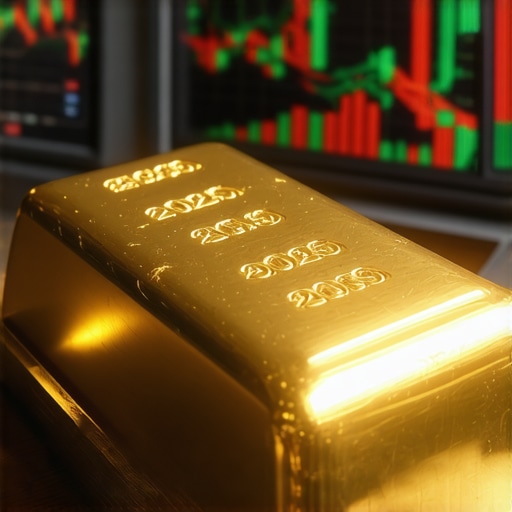Introduction to Economic Events and Gold
The gold market has always been intricately tied to the global economic landscape. Understanding how economic events influence gold prices is crucial for investors seeking to navigate the complexities of this precious metal. Gold is often viewed as a safe-haven asset, meaning its value tends to rise during periods of economic uncertainty or instability. In this article, we will explore the various economic events that impact gold prices and provide insights on how investors can leverage this knowledge.
The Role of Economic Indicators in Gold Prices
Economic indicators serve as a vital tool for investors to gauge the health of the economy and its potential impact on gold. Key indicators include inflation rates, interest rates, and employment figures. For instance, rising inflation typically leads to increased demand for gold as a hedge against devaluing currencies. When the purchasing power of money decreases, investors flock to gold to preserve their wealth. This dynamic creates upward pressure on gold prices.
Additionally, interest rates play a pivotal role in determining gold’s attractiveness. When interest rates are low, the opportunity cost of holding non-yielding assets like gold diminishes, making it a more appealing investment. Conversely, higher interest rates can lead to decreased gold demand as investors seek higher returns in interest-bearing assets. Understanding these economic indicators is essential for predicting gold price movements and making informed investment decisions.
How Economic Uncertainty Drives Gold Demand
Economic uncertainty, such as geopolitical tensions or financial crises, often leads to increased demand for gold. Investors view gold as a stable store of value during turbulent times. For example, during the 2008 financial crisis, gold prices soared as investors sought refuge from the volatility in stock markets. This behavior underscores the psychological aspect of investing in gold, where fear and uncertainty can significantly elevate its demand.
Moreover, central bank policies also play a critical role in shaping gold prices. Central banks often increase their gold reserves during uncertain times to bolster their financial security. This behavior can lead to a surge in gold demand, further driving up prices. For a deeper understanding of this phenomenon, consider exploring our page on the role of gold in economic uncertainty.
Global Events That Impact Gold Prices
In addition to domestic economic events, global happenings can also influence gold prices. Events such as trade wars, natural disasters, and political unrest can lead to increased volatility in the markets, prompting investors to seek safety in gold. For instance, the ongoing trade tensions between major economies can lead to currency fluctuations, which in turn affect gold prices.
Furthermore, understanding global demand trends is essential for investors. Countries like China and India are significant consumers of gold, and changes in their demand can have ripple effects on global gold prices. Keeping an eye on these trends can help investors make timely decisions and potentially capitalize on price movements.
Conclusion: Preparing for the Future of Gold Investments
In conclusion, understanding economic events and their impact on gold is crucial for any investor looking to navigate the complexities of the gold market. By staying informed about economic indicators, global events, and market trends, investors can better position themselves to make strategic decisions. For more insights into gold investments, check out our comprehensive guide on buying gold and explore various strategies to enhance your portfolio.
Analyzing Gold Price Volatility
Gold price volatility is a significant concern for investors, particularly during periods of economic instability. Understanding the factors contributing to this volatility can help investors navigate the gold market more effectively. Factors such as geopolitical tensions, changes in interest rates, and fluctuations in currency values can all contribute to gold price movements. For instance, when the U.S. dollar weakens, gold typically becomes more attractive to investors, leading to increased demand and higher prices.
The Impact of Geopolitical Tensions on Gold Prices
Geopolitical tensions often lead to uncertainty in the financial markets, prompting investors to flock to gold as a safe haven. Events such as wars, trade disputes, and diplomatic conflicts can create a surge in gold demand. For example, during the U.S.-China trade war, gold prices saw significant increases as investors sought protection from potential economic fallout. Keeping abreast of these developments is crucial for investors looking to time their gold purchases effectively.
Understanding the Role of Central Banks in Gold Trading
Central banks play a pivotal role in the gold market, influencing supply and demand dynamics through their buying and selling activities. When central banks increase their gold reserves, it typically drives up prices due to heightened demand. For instance, countries like Russia and China have been known to boost their gold holdings significantly, often as a hedge against economic instability. To learn more about how these actions affect gold prices, visit our page on gold demand trends.
Investing Strategies for Gold in Volatile Markets
For investors navigating the unpredictable gold market, adopting effective investment strategies is essential. Diversifying your portfolio with various gold assets, such as gold stocks, ETFs, and physical gold, can mitigate risks associated with price fluctuations. Gold stocks, for instance, often react differently to market conditions than physical gold, providing a balanced approach to investment. To explore more on this topic, check out our article on diversifying your portfolio with gold stocks.
Future Trends in Gold Demand and Price Predictions
Looking ahead, understanding future trends in gold demand is critical for investors. Factors such as increasing global economic uncertainty and the ongoing evolution of financial markets will likely influence gold’s attractiveness. Analysts predict that gold will continue to be a favored asset in times of crisis, with demand expected to rise as investors seek to protect their wealth. For a comprehensive outlook on what the future holds for gold prices, consider exploring our page on gold price predictions for 2025.
Conclusion: Positioning Yourself for Gold Investment Success
In conclusion, understanding the factors that drive gold price volatility and the various strategies to mitigate risk is vital for any investor. By staying informed about geopolitical events, central bank actions, and market trends, investors can make more strategic decisions regarding their gold investments. For further insights, refer to our guide on gold investment strategies and enhance your portfolio with informed choices.
Identifying Future Trends in Gold Demand
As we look toward the future, it’s essential to pinpoint factors that will influence gold demand. Economic uncertainty, inflation, and evolving investment behaviors are critical elements that will shape investor sentiment towards gold. Investors should keep an eye on the increasing interest in gold as a hedge against inflation, particularly in volatile economic climates. Additionally, as more individuals recognize the value of gold in diversifying their investment portfolios, demand is projected to increase significantly. For insights into current trends, explore our page on analyzing gold demand trends.
The Role of Gold in Inflationary Times
Gold has historically been viewed as a reliable asset during inflationary periods. When inflation rises, the purchasing power of currency diminishes, prompting investors to seek refuge in gold. This behavior often results in increased demand, driving prices upward. Therefore, understanding the relationship between inflation and gold prices is crucial for investors. For those interested in how gold can stabilize your investments during inflation, read our guide on how gold acts as a hedge.
Emerging Investment Strategies for Gold
Investors are increasingly adopting innovative strategies to incorporate gold into their portfolios. One effective approach is through Gold ETFs (Exchange-Traded Funds), which offer a convenient way to gain exposure to gold without the need for physical storage. Gold ETFs allow investors to track the price of gold while providing liquidity and flexibility. To learn more about this investment vehicle, check out our article on investing in gold ETFs.
Diversifying with Gold Stocks and Mutual Funds
Another strategy involves investing in gold stocks and mutual funds, which can provide exposure to the performance of gold mining companies. This strategy allows investors to benefit from the potential upside of both gold prices and the operational success of mining firms. However, it is essential to conduct thorough research to identify the best stocks and funds. For a deeper understanding of how to diversify your portfolio with gold stocks, visit our page on diversifying your portfolio with gold stocks.
Gold as a Safe Haven in Economic Turmoil
The perception of gold as a safe-haven asset remains steadfast, especially during economic turmoil. Investors tend to flock to gold during crises, leading to price surges. This behavior highlights the importance of timing in gold investments, as purchasing gold during periods of heightened demand can lead to significant returns. To understand the psychological factors influencing gold prices during uncertain times, explore our article on the psychology behind gold prices.
Conclusion: Preparing for Investment Success in Gold
In summary, being aware of future trends in gold demand and embracing innovative investment strategies is essential for success in the gold market. By diversifying your approach and understanding the factors that drive gold prices, you can position yourself to make informed investment decisions. For more insights into effective gold investment strategies, refer to our comprehensive guide on gold investment strategies and enhance your portfolio with knowledge and strategy.
Gold Investment Strategies for 2025
As we approach 2025, it’s crucial for investors to develop sound gold investment strategies that align with emerging market trends. With the ongoing fluctuations in the global economy, a well-thought-out approach will help mitigate risks while maximizing potential returns. One effective strategy is to incorporate a blend of physical gold, such as coins and bars, alongside gold ETFs and stocks. This diversification can create a balanced portfolio that leverages the benefits of both tangible assets and financial instruments. For guidance on how to effectively invest in gold, refer to our comprehensive guide to gold investment strategies.
Exploring Gold Market Predictions for 2025
Market analysts are predicting several key trends that could influence gold prices in 2025. These include geopolitical tensions, inflationary pressures, and shifts in consumer demand. Investors should stay informed about global events and how they can impact economic stability. Additionally, the rise of digital currencies and their influence on traditional assets like gold is worth monitoring. Understanding these dynamics can help investors make informed decisions and anticipate market movements. For a deeper dive into the future of gold prices, check out our article on gold price forecasts for 2025.
Physical Gold vs. Digital Assets: Making the Right Choice
As digital assets gain popularity, many investors are faced with the choice between physical gold and digital alternatives. While digital currencies offer high liquidity and ease of access, physical gold remains a tangible asset that can provide security during economic downturns. Maintaining a portion of your investment in physical gold can act as a hedge against inflation and currency fluctuations. To understand the pros and cons of each option, explore our post on physical gold vs. ETFs.
Assessing Gold Mining Stocks for Investment Potential
Investing in gold mining stocks can be a lucrative strategy, especially as gold prices rise. Mining companies often experience significant profit increases when gold prices soar, making them attractive investments. However, it’s essential to evaluate the operational efficiency and financial health of these companies before investing. Additionally, consider diversifying your holdings by investing in mutual funds that focus on gold mining stocks. This can spread risk while still capitalizing on the potential upside of the gold market. For more insights into investing in mining stocks, see our guide on investing in gold mining stocks.
The Importance of Staying Informed
In the fast-paced world of investing, staying informed about market trends is paramount. Subscribing to financial news outlets, attending investment seminars, and engaging with industry experts can empower investors to make educated choices. Additionally, leveraging resources such as our gold market analysis can provide valuable insights into current trends and future predictions. Empower yourself with knowledge to effectively navigate the complexities of gold investing.
Conclusion: Preparing for Future Gold Investments
In conclusion, understanding future trends in gold demand, developing innovative investment strategies, and staying informed are vital components of successful gold investing. As we move toward 2025, the landscape of gold investments will continue to evolve, influenced by economic, political, and social factors. By diversifying your portfolio and remaining proactive, you can position yourself for success in the gold market. For more comprehensive insights into investing in gold, explore our comprehensive guide to buying gold. Embrace the opportunities within the gold market to safeguard and grow your wealth in the years to come.
Frequently Asked Questions About Gold Investment
As the gold investment landscape evolves, many investors have questions about strategies, market trends, and the implications of current events on gold prices. Below are some of the most common inquiries regarding gold investment, along with expert resources to guide you.
What are the main benefits of investing in gold?
Investing in gold offers several advantages, including its status as a safe-haven asset during economic downturns, a hedge against inflation, and portfolio diversification. Gold’s historical value and liquidity make it a reliable investment for wealth preservation.
How can I start investing in gold?
To begin investing in gold, you can purchase physical gold (such as coins and bars), invest in gold ETFs (Exchange-Traded Funds), or buy shares in gold mining companies. Each option has its own set of risks and rewards, so consider your investment goals and risk tolerance.
What factors influence gold prices?
Gold prices are influenced by various factors, including geopolitical tensions, inflation rates, currency strength, and changes in interest rates. Awareness of these factors can help investors make informed decisions about when to buy or sell gold.
Is it better to invest in physical gold or gold stocks?
The choice between physical gold and gold stocks depends on your investment strategy. Physical gold provides tangible security and can act as a hedge against economic instability, while gold stocks can offer higher potential returns but come with added risks associated with mining operations.
What role does gold play in a diversified investment portfolio?
Gold acts as a stabilizing asset in a diversified investment portfolio. It tends to perform well during market volatility and can help mitigate risks associated with other investments such as stocks and bonds. Allocating a portion of your portfolio to gold can enhance overall performance.
How do I determine the right amount of gold to invest in?
Determining the right amount of gold to invest in depends on your financial goals, risk tolerance, and investment timeline. Financial advisors often recommend allocating between 5-10% of your portfolio to gold as a general guideline for diversification.
What are the risks associated with gold investing?
While gold can be a safe-haven asset, it is not risk-free. Prices can be volatile, and the market can be influenced by external factors such as economic events and changes in investor sentiment. Additionally, physical gold involves storage and insurance costs.
How can I keep track of gold market trends?
To stay informed about gold market trends, consider subscribing to financial news outlets, following market analysts on social media, and utilizing resources such as our gold market analysis. Engaging with industry experts and participating in investment webinars can also provide valuable insights.
Where can I find authoritative resources on gold investment?
Authoritative resources on gold investment can be found through financial institutions, investment firms, and dedicated gold investment websites. Some reputable sources include the World Gold Council, the U.S. Geological Survey, and financial publications like Bloomberg and Forbes.
Conclusion: Navigating the Future of Gold Investment
As the gold investment landscape continues to evolve, understanding key trends and strategies is essential for successful investing. By diversifying your portfolio, staying informed about market dynamics, and leveraging resources like expert analyses, you can effectively navigate the complexities of gold investments. Whether you choose to invest in physical gold or gold stocks, aligning your strategies with your financial goals will help you capitalize on the opportunities within the gold market as we approach 2025.










